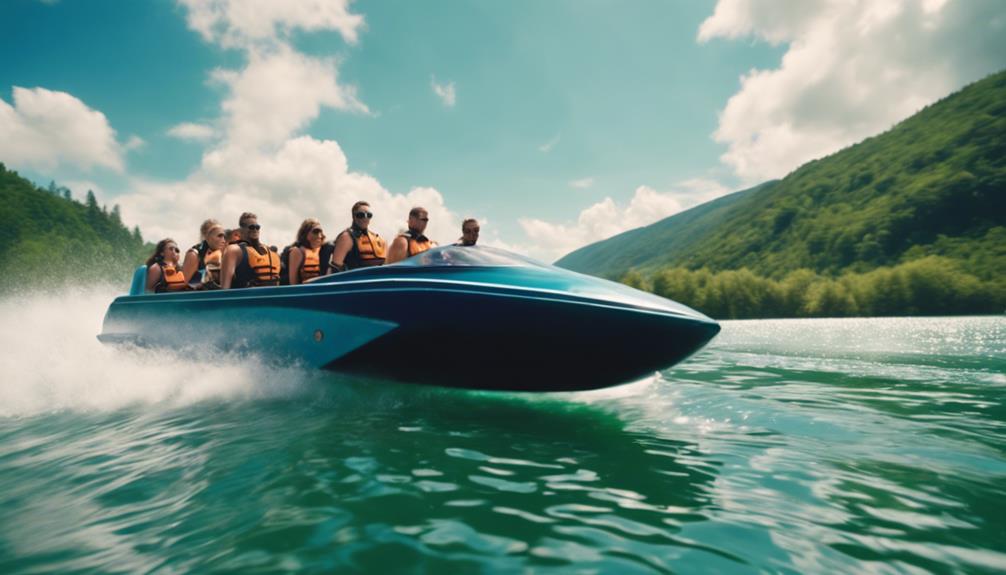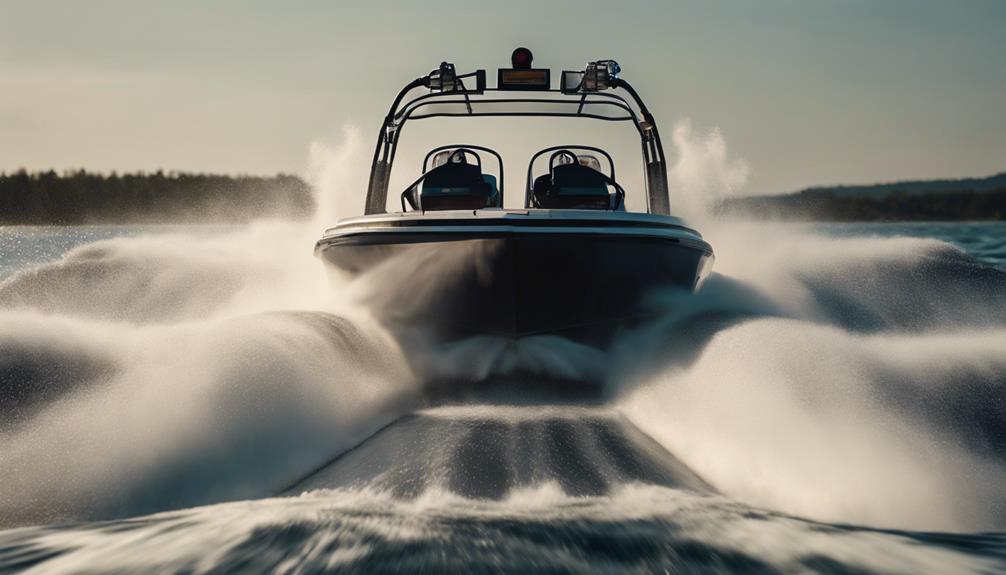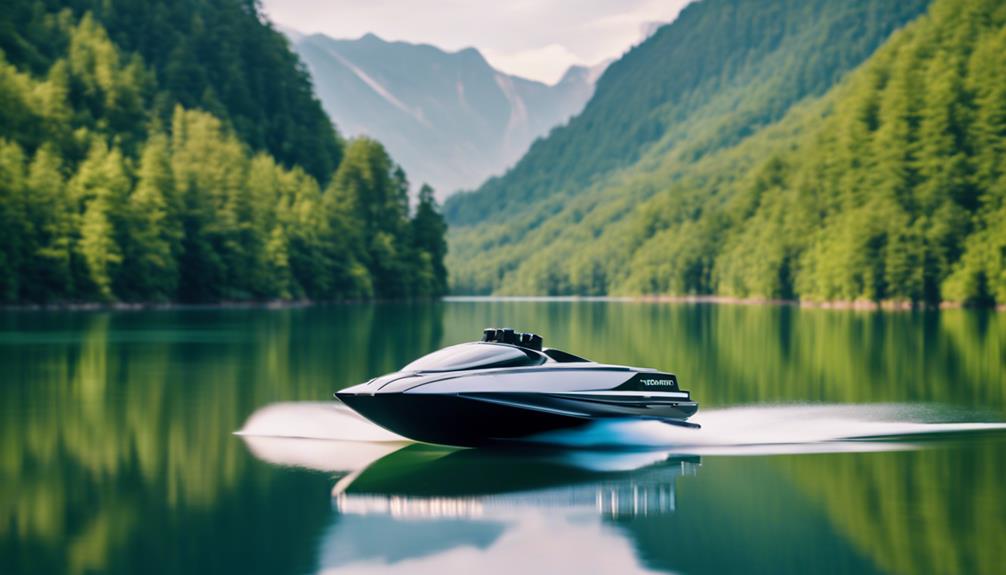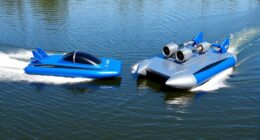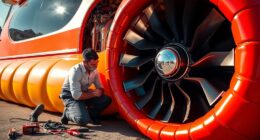Yes, jet boats can be bad for the environment. They generate significant noise pollution, disturbing wildlife and affecting their communication. Operating in shallow waters stirs up sediment, harming fish habitats and increasing turbidity, which reduces light for aquatic plants. Additionally, poorly maintained engines may leak pollutants into waterways. While newer four-stroke models are more efficient, older two-stroke engines emit higher amounts of harmful substances. The cumulative impact can lead to long-term ecosystem degradation. Understanding these factors is essential, and discovering more about responsible boating practices might just surprise you.
Key Takeaways
- Jet boats, especially older 2-stroke models, produce high noise levels exceeding 85 decibels, disrupting marine life communication and behaviors.
- Operating in shallow waters, jet boats stir up sediment, leading to habitat degradation and declining fish populations.
- Jet boats consume 12-15 gallons of fuel per hour, contributing to significant emissions of unburned hydrocarbons and nitrogen oxides.
- Increased turbidity from jet boat operations hinders aquatic plant photosynthesis, negatively impacting biodiversity and water quality.
Environmental Impact of Jet Boats
Jet boats can greatly impact the environment, particularly through noise pollution and habitat disruption. When you operate a jet boat, especially a 2-stroke model, the noise levels can be considerably higher than other recreational vessels. This noise can disturb wildlife, leading to stress and changes in natural behaviors, ultimately impacting aquatic ecosystems.
In shallow waters, jet boats can stir up sediment, which not only affects water clarity but also disrupts fish habitats. Increased sediment disturbance can lead to poor water quality, making it harder for aquatic life to thrive. Additionally, jet drive systems often suck in debris like weeds and rocks, which can contribute to pollution and further disrupt the ecosystem.
Regular maintenance is essential. If you neglect upkeep, you risk oil leaks and other pollutants entering the waterways, harming aquatic life and their habitats.
With awareness of these environmental impacts, you can make informed decisions about using jet boats responsibly, ensuring that your enjoyment doesn't come at the expense of the ecosystems you cherish.
Fuel Consumption and Emissions

When considering jet boats, you should pay close attention to their fuel efficiency and emissions.
These factors not only determine your operating costs but also have a significant impact on the environment.
Understanding the differences in fuel consumption and compliance with emission standards is essential for making informed choices.
Fuel Efficiency Comparison
Compared to traditional propeller-driven boats, jet boats generally have higher fuel consumption rates, often averaging around 12-15 gallons per hour at increased speeds. This fuel efficiency comparison highlights a significant concern for environmentally conscious boaters.
Here are some key points to evaluate:
- Engine Types: Two-stroke jet boats consume more fuel and emit higher levels of unburned hydrocarbons compared to four-stroke models.
- Variability: Fuel efficiency can vary widely based on engine size and operating conditions, with some newer models using technology that improves consumption by up to 30%.
- Pollution Impact: Jet boats release harmful pollutants like nitrogen oxides (NOx) and particulate matter, which can adversely affect local ecosystems, especially in shallow waters.
- Noise Consideration: Older two-stroke models also tend to produce more noise, potentially disrupting wildlife and recreational activities, further amplifying their environmental impact.
Emission Standards Compliance
As boaters become more aware of their environmental impact, compliance with emission standards has become a key focus for the jet boat industry.
Older jet boats, especially those with 2-stroke engines, typically produce higher emissions, contributing to pollution in waterways. You might be pleased to know that many manufacturers are shifting towards 4-stroke engines to meet stricter emission standards compliance. This change not only enhances fuel efficiency but also greatly reduces harmful emissions.
Modern 4-stroke models average around 4 to 6 gallons per hour, which is a marked improvement over their 2-stroke counterparts. Some regions are even enacting regulations to limit the use of high-emission watercraft in sensitive ecosystems, emphasizing the importance of adhering to these standards for environmental protection.
Additionally, advancements like direct fuel injection are being introduced to further decrease emissions while improving fuel efficiency. By choosing compliant jet boats, you can enjoy your time on the water while contributing to a healthier environment.
It's crucial to stay informed about which models meet current emission standards compliance to make a responsible choice for both your boating experience and the planet.
Environmental Impact Assessment
Jet boats often consume more fuel than traditional boats, resulting in higher emissions that can negatively affect the environment. This increased fuel consumption is primarily due to the jet drives used in these vessels, which can lead to a variety of environmental issues.
Here are some key points to evaluate:
- Higher Emissions: Jet boats, especially those with 2-stroke engines, emit more unburned hydrocarbons and particulate matter, considerably impacting air quality.
- Noise Pollution: Operating at full throttle, jet boats can produce noise levels exceeding 85 decibels, disturbing both wildlife and recreational users in the area.
- Habitat Disruption: Their shallow draft enables access to sensitive habitats, but this can lead to sediment displacement and degradation of aquatic ecosystems.
- Maintenance Matters: Regular maintenance and proper fuel management are essential. Poorly maintained engines can release even more pollutants, amplifying their environmental footprint.
Effects on Aquatic Ecosystems
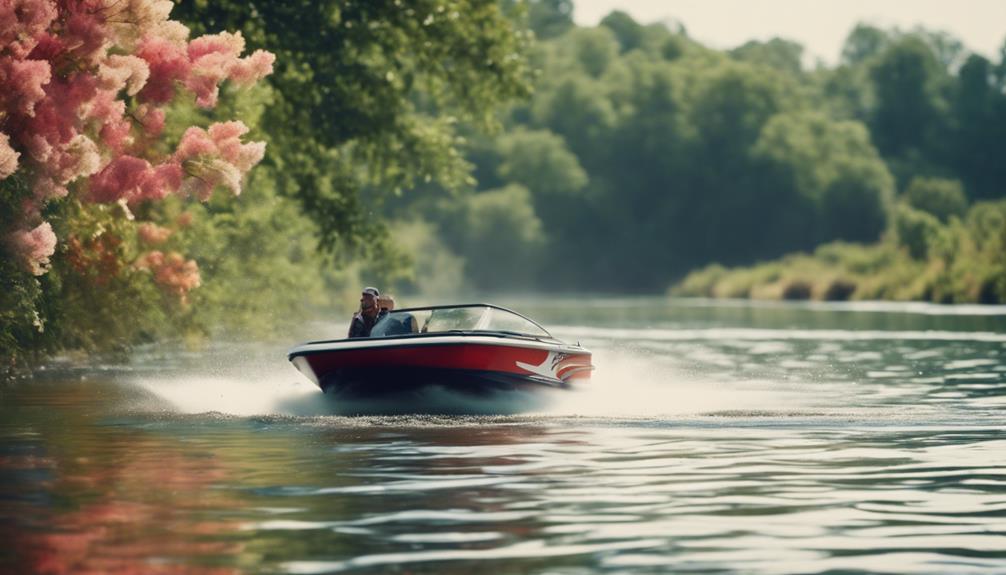
When you take a jet boat out on the water, you're not just enjoying the thrill; you could also be impacting the aquatic ecosystem around you.
The noise and turbulence from these boats can disrupt local wildlife, while their shallow operation can damage sensitive habitats.
It's crucial to reflect on how your recreational activities might affect fish spawning grounds and overall water quality.
Propeller Impact Assessment
Propeller wash from boats disturbs sediment in shallow waters, threatening sensitive aquatic ecosystems. When you consider jet boats, it's important to understand the impact they can have on these environments. The mechanical disturbance caused by their operation can lead to several adverse effects:
Increased Turbidity: Jet boats can greatly raise the turbidity of water, which reduces light penetration. This affects the photosynthesis of aquatic plants, disrupting the entire food chain.
Harm to Spawning Grounds: Propeller action can damage critical fish spawning habitats, leading to a decline in fish populations in areas with high boating activity.
Sediment Disruption: The disturbance of sediment can release harmful pollutants and nutrients, worsening water quality and impacting aquatic life.
Long-term Ecosystem Changes: The cumulative effects of these disturbances can lead to long-term degradation of habitats, impacting biodiversity and ecosystem health.
As you engage with jet boats, it's important to recognize these impacts on aquatic ecosystems. Making informed choices can help protect these fragile environments for future generations.
Noise Pollution Concerns
Noise pollution from boats, especially older models, considerably disrupts aquatic ecosystems and can interfere with the natural behaviors of wildlife.
When jet boats operate, particularly those with older 2-stroke engines, they can produce noise levels exceeding 90 decibels. This loudness can mask essential communication signals among marine animals, which are significant for feeding and mating practices. Fish spawning and predator-prey interactions suffer, leading to substantial shifts in behavior.
Prolonged exposure to these high noise levels can stress sensitive species, including certain fish and marine mammals, ultimately decreasing their survival rates. You mightn't realize it, but this noise pollution alters the natural soundscape of waterways, making it harder for organisms that rely on sound for navigation and survival to thrive.
As a result, many aquatic creatures may abandon their habitats due to the disruptive effects of noise pollution, which negatively impacts biodiversity and the overall health of the ecosystem.
These noise pollution concerns highlight the importance of considering the environmental implications of using jet boats, especially in sensitive aquatic environments.
Habitat Disruption Risks
Jet boats pose significant habitat disruption risks by stirring up sediment in shallow waters, which can smother aquatic plants and undermine crucial spawning grounds for fish species. The consequences of this disruption extend beyond just the immediate area.
Here are some key habitat disruption risks you should consider:
- Shoreline Erosion: The intense wake created by jet boats can erode shorelines, affecting nesting sites for birds and other wildlife that rely on stable environments.
- Disruption of Food Chains: Jet propulsion systems can inadvertently draw in small aquatic organisms, harming them and affecting the food chain's overall health.
- Increased Turbidity: In sensitive habitats like wetlands, jet boats can increase turbidity, which limits light penetration and hinders the growth of crucial underwater vegetation.
- Wildlife Behavioral Changes: Studies show that the noise generated by jet boats can disturb wildlife behaviors, particularly in sensitive species like fish and amphibians, disrupting their breeding and feeding patterns.
Noise Pollution Concerns
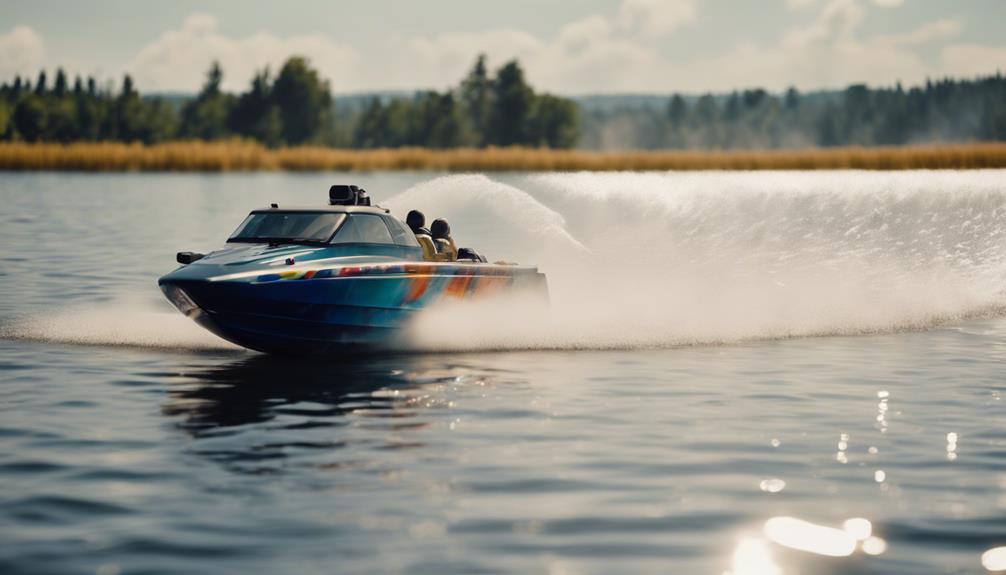
The loud roars of 2-stroke jet boats can easily disrupt local wildlife and the tranquility of nearby communities. These boats often produce noise levels exceeding 85 decibels, which can have significant repercussions on both marine life and human populations. You need to take into account how this noise pollution affects communication among marine species, leading to disrupted mating and foraging behaviors.
| Noise Source | Average Decibel Level | Impact on Wildlife | Impact on Communities |
|---|---|---|---|
| Jet Boats (2-stroke) | > 85 dB | Disrupted communication | Decreased quality of life |
| Recreational Boating | 70-85 dB | Reduced fish populations | Increased stress levels |
| Motorboats | 80-90 dB | Altered behaviors in aquatic life | Annoyance and disturbance |
| Other Watercraft | 60-75 dB | Lesser impact on ecosystems | Minimal disruption |
Studies show that the noise pollution concerns associated with jet boats can lead to reduced populations of sensitive fish species in heavily trafficked waterways. As regulatory bodies evaluate stricter noise limits, it's vital to address these issues to protect both aquatic ecosystems and the well-being of shoreline communities.
Debris Ingestion Risks

While noise pollution poses significant challenges for wildlife, another pressing concern for jet boats is their susceptibility to debris ingestion, which can severely impact engine performance and environmental health. When operating in shallow waters, you face increased debris ingestion risks that can lead to serious issues.
Here are four key points to take into account:
- Performance Issues: Jet drive systems can easily suck in ropes, rocks, and weeds, causing engine damage and reduced efficiency.
- Fuel Inefficiency: Ingested debris can decrease engine efficiency, leading to higher fuel consumption and increased emissions.
- Maintenance Needs: Regular inspections are vital, as accumulated debris in the impeller can create blockages, resulting in costly repairs.
- Environmental Impact: When engines operate inefficiently due to debris, they can expel unburned fuel and oil into the water, harming aquatic ecosystems.
Understanding debris ingestion risks is important for maintaining your jet boat and protecting the environment. By staying vigilant and performing routine maintenance, you can help mitigate these risks and guarantee your jet boat operates efficiently.
Comparison With Other Boats
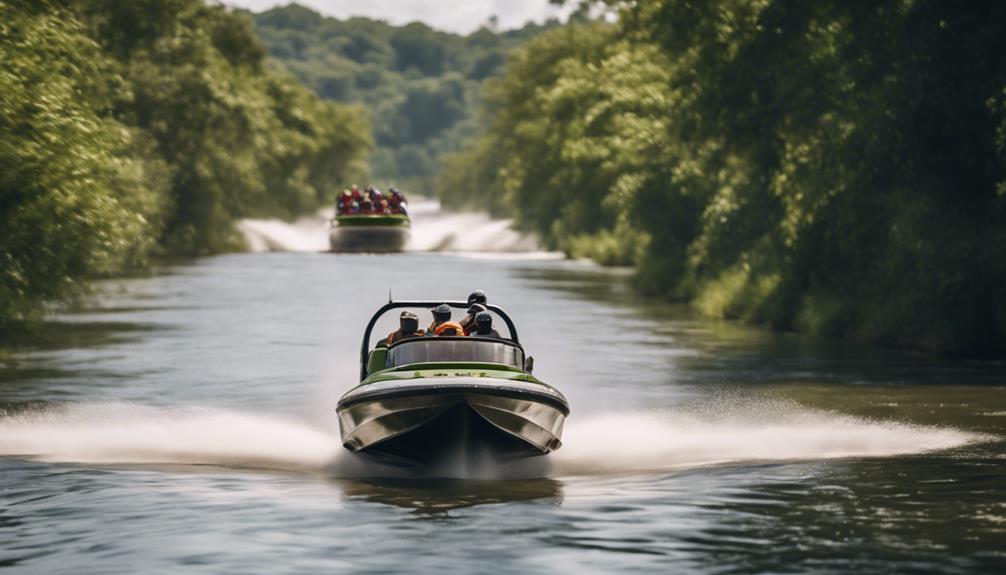
When comparing jet boats to traditional propeller-driven models, you'll notice distinct advantages and disadvantages that can influence your choice based on environmental impact and performance needs.
One of the major pros of jet boats is their shallower draft, which allows them to navigate in shallow waters without disturbing sediments, reducing environmental impact in sensitive areas. Additionally, the absence of exposed propellers minimizes the risk of injury to aquatic wildlife, making jet boats a safer option for ecosystems.
However, there are also significant cons to take into account. Jet boats often produce higher noise levels, particularly in 2-stroke models, which can disrupt local wildlife habitats. They typically require higher RPMs for operation, leading to increased fuel consumption, although newer models may offer lower emissions compared to older outboard engines.
Maintenance plays a vital role in the environmental footprint of any boat, including jet boats. Regular inspections and proper care can mitigate potential issues like oil leaks, which may harm waterways.
Ultimately, weighing the pros and cons of jet boats versus traditional models can help you make a more informed decision regarding your boating choice and its environmental implications.
Safety Vs. Environmental Trade-Offs

Jet boats often strike a balance between safety and environmental concerns, making it essential for operators to evaluate both aspects when maneuvering through sensitive areas. While jet boats provide safer experiences for swimmers due to their lack of exposed propellers, they also present environmental challenges that shouldn't be overlooked.
Here are a few key considerations:
- Emissions: Jet boats typically emit fewer pollutants than traditional two-stroke engines, benefiting air and water quality.
- Shallow Draft: Their design allows navigation in shallow waters with less disturbance to aquatic habitats compared to deeper-draft vessels.
- Noise Pollution: Despite eliminating exposed propellers, jet boats can create noise pollution due to high RPM operation, potentially disrupting local wildlife.
- Sediment Disturbance: Jet boats may inadvertently suck up debris, increasing sediment disturbance, which can harm local ecosystems if not carefully managed.
Balancing these factors is vital.
As you enjoy the thrill of jet boating, being mindful of your impact on the environment will help preserve the beauty and health of our waterways for future generations.
Future of Jet Boat Technology
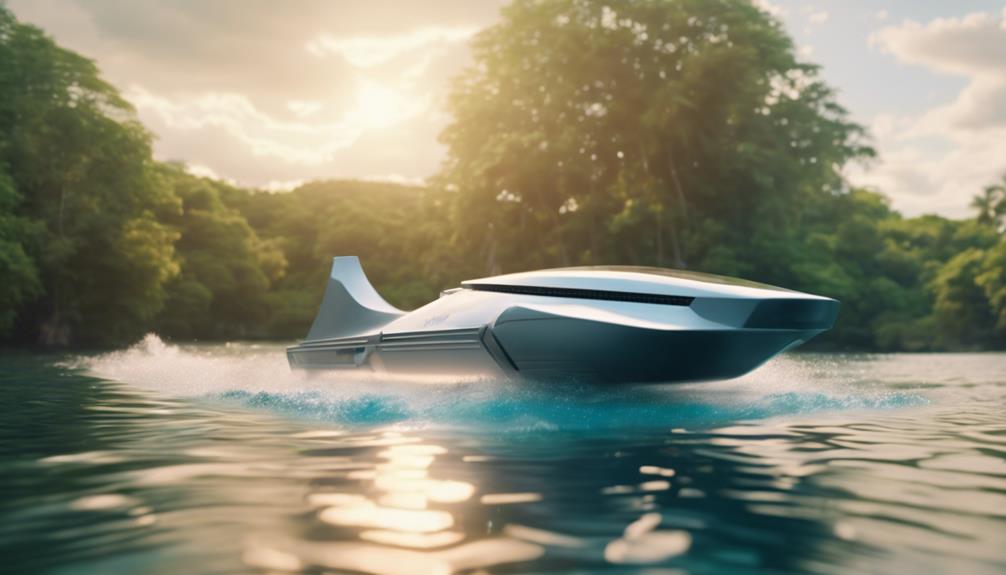
The future of jet boat technology promises exciting advancements that prioritize environmental sustainability and performance efficiency.
You'll find that manufacturers are increasingly focusing on meeting stricter emission standards, producing cleaner engines that align with EPA regulations. This shift not only enhances performance but also minimizes harmful pollutants.
You can expect to see a rise in hybrid and fully electric jet models that offer reduced noise and zero-emission options, making your recreational boating experiences more eco-friendly. Additionally, innovations like noise reduction technologies will greatly lower engine noise levels, contributing to a more enjoyable time on the water.
Jet boats are also being constructed from lightweight, recyclable materials, which improve performance and lessen their environmental impact during both production and disposal. Many manufacturers are committing to sustainability initiatives, such as utilizing biofuels and promoting responsible boating practices to protect aquatic ecosystems.
As you look toward the future, these advancements in jet boat technology won't only enhance your experience but also help guarantee that your passion for boating coexists harmoniously with the environment.
Frequently Asked Questions
What Are the Negatives of a Jet Boat?
Jet boats can be noisy, especially 2-stroke models, and they might disrupt local ecosystems by sucking up debris. Their shallow draft can erode riverbanks and increase turbidity, negatively impacting aquatic life around you.
What Are the Risks of Jet Boats?
When you use jet boats, you risk increased noise pollution, potential harm to aquatic ecosystems from debris intake, and shoreline erosion due to their shallow draft. Their fuel consumption also elevates emissions, impacting local water quality.
Are Jet Boats Bad for Rivers?
Jet boats can impact rivers in various ways. While their shallow draft minimizes disruption, their noise and potential debris intake can harm aquatic life. Regular maintenance is essential to mitigate risks and protect river ecosystems.
Are Jet Boats Safer Than Prop Boats?
Jet boats are like the superheroes of watercraft! They offer superior maneuverability and quick acceleration, making them safer than prop boats. However, their unique handling at low speeds can be tricky in tight spots.
Do Jet Boats Pose Environmental Threats as Well as Safety Risks?
Jet boats are known for their speed and maneuverability, but they can also pose environmental threats and safety risks. To minimize these risks, it’s important to follow jet boat safety tips such as maintaining a safe speed, being aware of surroundings, and properly disposing of any waste or fuel.
Conclusion
In summary, jet boats can leave a significant mark on the environment, much like a stone skimming across a calm lake, creating ripples that reach far and wide.
Their fuel consumption, emissions, and noise pollution raise valid concerns about their impact on aquatic ecosystems.
As technology advances, there's hope for greener alternatives, but it's essential to weigh safety against environmental consequences.
By staying informed, you can make better choices for both your adventures and the planet.


